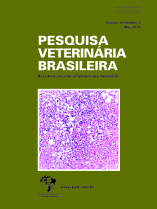 |
|
|
|
Year 2019 - Volume 39, Number 5
|

|
Effect of eCG on the follicular dynamics and vascularization of crossbred cows with different circulating progesterone concentrations during synchronization of ovulation in an FTAI protocol, 39(5):324-331
|
ABSTRACT.- Ferraz P.A., Silva M.A.A., Carôso B.S.S., Araujo E.A.B., Bittencourt T.C.B.S.C., Chalhoub M., Bittencourt R.F. & Ribeiro Filho A.L. 2019. Effect of eCG on the follicular dynamics and vascularization of crossbred cows with different circulating progesterone concentrations during synchronization of ovulation in an FTAI protocol. Pesquisa Veterinária Brasileira 39(5):324-331. Departamento de Anatomia, Patologia e Clínicas Veterinárias, Universidade Federal da Bahia, Rua Ademar de Barros 500, Ondina, Salvador, BA 40170-110, Brazil. E-mail: prisferraz@gmail.com
This study aimed to evaluate the effect of treatment with equine chorionic gonadotrophin (eCG) on the follicular dynamics and function of crossbred cows with different circulating progesterone (P4) concentrations during synchronization of ovulation in a fixed-time artificial insemination (FTAI) protocol. To this end, 30 crossbred cows were submitted to a pre-synchronization protocol to ensure that all of them presented corpus luteum (CL) at the beginning of the protocol, and were evaluated by transrectal ultrasonography (TRUS) to verify the presence of CL. After that, the animals underwent an ovulation synchronization protocol and evaluation of follicular dynamics and vascularization by B-mode and power-Doppler ultrasound (US). High plasma P4 concentrations at the time of ovulation synchronization negatively influenced follicle diameter on day 10 (D10), preovulatory follicle diameter, and preovulatory follicle wall vascularization area (p<0.05). Cows with high P4 concentration at the time of ovulation synchronization that were treated with eCG showed follicle diameter on D10 and preovulatory follicle diameter and wall vascularization area (p>0.05) similar to those of animals with low P4 concentration at the time of ovulation synchronization. Therefore, high P4 concentrations at the time of ovulation synchronization negatively influence follicular diameter and vascularization, and eCG can be used as a strategy to favor better follicular and luteal response in crossbred cows with high P4 concentrations submitted to an FTAI protocol. |
| |
|
|
| |
|
 |